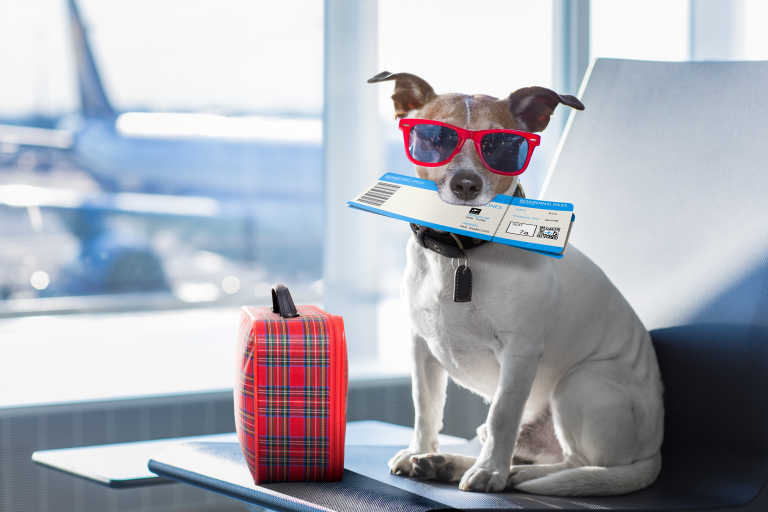How to fly with your pet on planes
Pets are a massive part of the family. They keep us company and make us laugh, making fantastic companions that often feel like best friends, too. Sometimes, they are the only ones that truly understand us - they get us! Pets come everywhere with us, from a trip to a family get-together or a drive across the country, they are always by our side. But what happens when we need to fly? Below is a good guide on how you can take your pet with you safely and lawfully when you travel by plane.
- How pets fly
- Which airlines allow pets?
- Which animals are allowed?
- How much does it cost to take a pet on an airplane?
- Make plans in advance
- Your pet, your responsibility
How pets fly
Each airline has different rules about whether animals are allowed on-board and how pets are looked after on their aircraft. Depending on the type, size, and breed of the animal, some pets might be allowed in the cabin. This is only allowed if there is enough space under the seat. Planes with smaller cabins don't generally allow carry-on pets.
Where they are allowed, the animal would need to remain in a comfortable carrier or crate. Animals would have to be able to sit, stand, and turn around inside the crate without touching any side. Normally, the animal and the carrier should not be more than 22 pounds. Because of their size and weight, a lot of animals will need to go in the cargo hold for the whole of the journey.
Which airlines allow pets?
Quite a number of Canadian airlines allow pets on their aircraft. Airlines, such as Air Canada, WestJet and Porter Airlines, allow passengers to fly with a pet, but each has different restrictions. For example, Porter Airlines restricts to house cats and small dogs only that weigh no more than 9 kg (20 lb), including the pet carrier.
Air Canada pet policy also varies depending on the type of aircraft and cabin class the traveler will be flying on. For example, passengers on Premium Economy class would not be able to take their pets onboard. This is due to their seat layout which does not allow for safe stowage of a pet carrier. WestJet currently does not accept checked animals on the 787 Dreamliner.

Which animals are allowed on planes?
Cats and dogs are allowed on most airlines that allow pets to fly. The general rule is that the animal must have been weaned off. With regards to age, most allow pets that are at least 12 weeks old although this may vary depending on the airline.
Pets, other than dogs and cats, may be allowed on some airlines. Passengers are advised to always make sure they check their pet's scientific name online or with your vet to determine if it is safe to fly. Depending on the travel destination, some animals may not be allowed to enter, so please consolidate with your veternarian. Most airlines allow service animals onto their planes, however, emotional support or psychiatric service animals may have certain restrictions. For example, Air Canada does not accept emotional support or psychiatric service animals on their international flights, however, allowed on flights between Canada and the United States. Whenever travelling with any pet, advanced notification to the airline is required prior to arriving at the airport to check the availability, as well as, certain documents may be required.
How much does it cost to take a pet on an airplane?
The cost to take a pet on an airplane depends on the distance of the flight and the airline in question. It also depends on whether the animal is in the cargo hold or flying in the cabin with you. Cabin fees range between $50 up to around $118 for one-way. The cargo fees range between $105 to $320 for one-way.
Make plans in advance
Many airlines have a limited number of spaces allocated for pets on their aircraft. For this reason, it is advisable for passengers to make arrangements well ahead of their travel date. It is often sensible to make sure to call the airline and explain the situation before the ticket is booked, to ensure that the aircraft can accommodate the booking. Also, it is best to use direct flights where possible. Flights that involve stopovers and changes can cause a stressful environment for animals.
Your pet, your responsibility
Note that even though these airlines allow passengers to fly with their pets, it is ultimately the owner's responsibility to take care of the animal. Airlines assume no liability for the health or safety of your pets when in transit. It is also a passenger's responsibility to fulfil entry requirements before they arrive at their destination. When flying out of Canada, for example, some travel destinations may require additional documents as your pet may go through government veterinary inspections, and the certificate issued by your local vet may not be sufficient enough. You may need to contact the Embassy or Consulate for the country you are travelling to for the most updated information and requirements. Though sedation is not advised, make sure you inform the airline crew about medication and doses or any prescription medicine that your pet requires.
Book now through BudgetAir and make unforgettable memories with your pets!
